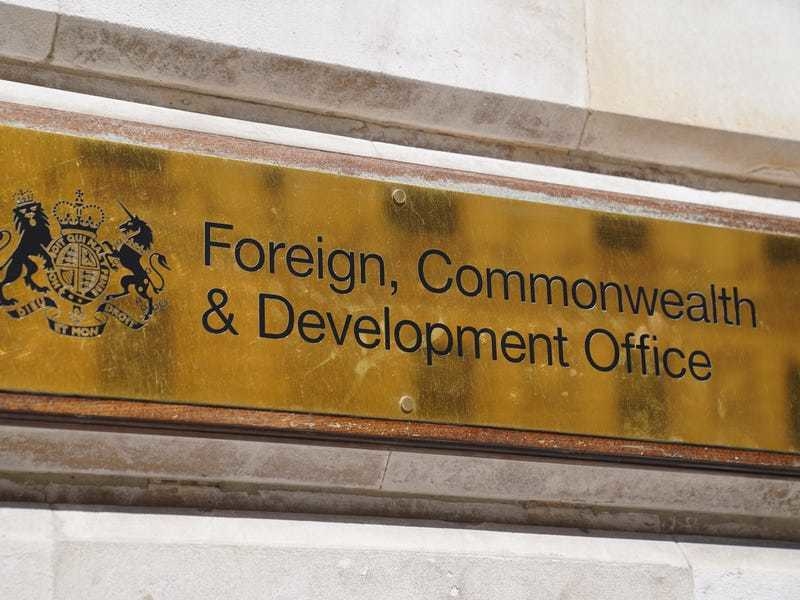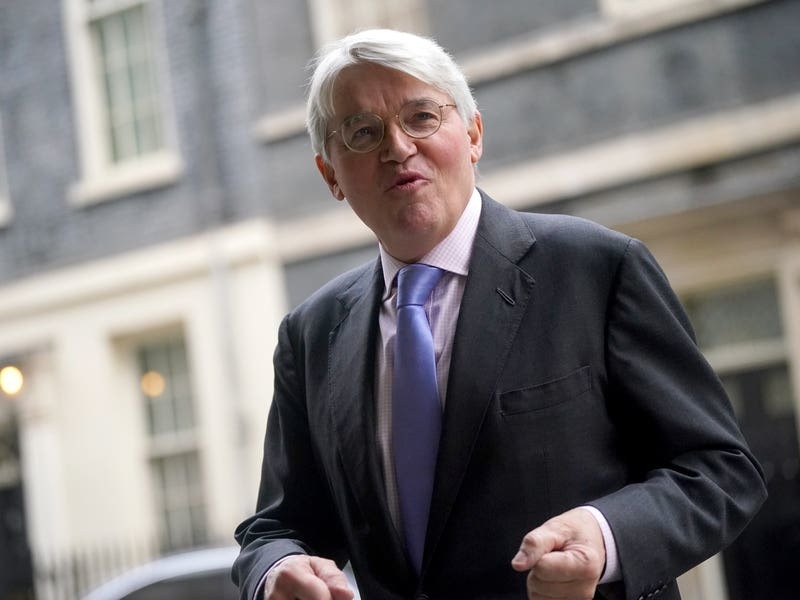Sceptics suggested President Emmanuel Macron made the offer only after Britain submitted to French demands for £45 million to tighten controls to stop migrants entering England via Calais.
Perhaps the real stitch-up was performed by the Anglo-Saxons on the Normans in weaving their version of events surrounding 1066 into the famous fabric.
The common view is that the tapestry was a piece of Norman propaganda. However, Andrew Bridgeford, a Jersey lawyer and author of 1066: The Hidden History of the Bayeux Tapestry, believes that the tapestry is likely to have been made in England – ‘modern scholarship has substantially established that the tapestry was made in St Augustine’s Abbey in Canterbury’ – and he argues it contains a subtle record of the English version of events.
‘There has long been a popular assumption that it’s Norman propaganda and there is an old story in Bayeux that it was stitched by Duke William’s wife Queen Matilda and her ladies in waiting, to justify and celebrate the Norman invasion of England,’ says Mr Bridgeford (58), who lives in Grouville.
‘Historians don’t believe that anymore, the tapestry is much more likely to be an Anglo-Saxon version of those events.
‘This is particularly clear in a scene from the tapestry where Harold returns from Normandy having sworn an oath to support William Duke of Normandy’s claim to the throne.
‘He’s shown in the pictures as being reprimanded for his actions by England’s King Edward the Confessor – whereas according to the Normans, King Edward wanted Harold to go to Normandy to swear an oath to William.
‘And the picture of Harold being reprimanded by Edward corresponds with an English source from Canterbury.
‘Secondly, the tapestry depicts Edward’s deathbed scene where he designates Harold as his chosen successor. The scene corresponds in great detail to an account called The Life of King Edward that was commissioned by Harold’s sister. This shows the close connection between the tapestry’s design and the Anglo-Saxon written sources.’
Mr Bridgeford says that although the Norman and Anglo-Saxon version of events tally up by the end, Harold is depicted in the tapestry as something of a hero.
‘The Anglo-Saxons’ [take on events] ultimately converges with the Norman version of events because the Anglo-Saxons, seeking to explain what had happened, saw Harold as being punished by God for having broken his oath to William and therefore there was a divine outcome in Harold’s death and William’s victory.
‘But in many ways the tapestry is a story of Harold as a tragic hero rather than a villain.’
He says one of several scenes that illustrate this is when Harold is pictured rescuing two Norman soldiers from the quicksands surrounding the island commune of Mont Saint-Michel.
‘That is not something that occurs in any of the written sources that have survived and again it shows one of the ways in which the Anglo-Saxons were telling us that Harold was brave, strong and noble.’
Mr Bridgeford also suggests that it was not William who killed Harold, but Count Eustace II of Boulogne – and insists the clues are in the canvas.
‘Count Eustace is described as one of the killers of Harold by the very earliest written source and although I can’t prove it, one of the things I suggest in my book is that the second figure shown killing Harold is meant to be a cryptic portrait of Count Eustace.
‘The inscription in Latin above the death scene reads “Hic Harold Rex Interfectus Est”, which means “Here King Harold is Killed”. “Interfectus” – which means killed – should be all one word, but the letters and the sentence have been broken up, so you get “Hic Harold Rex Interfec” and “Tus Est” is on the line below.
‘If you turn “Tus Est” round it becomes Est Tus which could be read as an abbreviation of the name Eustatius – the Latin for Eustace.’
Mr Bridgeford insists that while most of us see the events surrounding the Battle of Hastings in binary terms, the situation was more nuanced with Count Eustace one of the period’s main protagonists.
‘We naturally think of the Battle of Hastings as Anglo-Saxons against Normans, but William had allies from other parts of northern France, chief amongst whom was Count Eustace.
‘The great mistake has always been to simply refer to Count Eustace as a Norman knight, but he wasn’t a Norman at all – he was a count of his own territory and was, in many ways, a rival for influence in northern France. He could have sided with the Anglo-Saxons as he had been married to Edward the Confessor’s sister and had his own claim on the English throne.
‘He decided to fight on the Norman side, but after the Battle of Hastings he rebelled against William in 1067 and attacked Dover Castle with the English. It was a complete disaster for him and he was then exiled from England.’
He adds: ‘The puzzle is why Count Eustace is depicted and named in the tapestry as one of the heroes of the Norman side because after 1067 he was a villain in Norman eyes – and the tapestry was most likely made in the 1070s.’
Mr Bridgeford believes that those who wove the tapestry did so to show Eustace in the most favourable light.
‘Count Eustace managed to engineer a reconciliation with William in the early 1070s. My take on this is the tapestry belongs to that period of reconciliation between William and Count Eustace.
‘What is without doubt is that the count was renowned as the foremost descendent of the French Emperor Charlemagne, and was the father of the most famous crusader of them all, Godfrey of Bouillon, who captured Jerusalem in 1099.
‘What is more, Eustace’s wife became a saint and Eustace himself became connected to the stories of the Swan Knight and Holy Grail in later medieval myths.
‘And if you go forward to the modern mythology of Dan Brown’s [mystery thriller novel] The Da Vinci Code, Count Eustace’s family is part and parcel of that as well.’
Although the tapestry, says Mr Bridgeford, may appear to be the product of folk art, it was ingeniously designed with ambiguity purposely woven into the narrative.
‘The tapestry is very cleverly designed so people can take different meanings from it and it is full of symbolism. We see astrological symbols and we see references to Aesop’s Fables with the fox and the crow, although who is the fox and who is the crow is open to interpretation.’
Since it was published in 2004, Mr Bridgeford’s book – which was printed in US, French and British editions – has made a significant contribution to the scholarly debate on the famous 70-metre long embroidery – and he is planning to write an update on his website.
‘I’m going to start work on some new ideas that I’ve had, to add to some of these theories.’
Once that is finished, he may wish to send a copy of the updated work Prince Philip’s way, as his book came in for royal approval shortly after it went on sale.
‘I had a very interesting letter, which took me completely by surprise, from his Royal Highness Prince Philip. He said he had been given my book for his birthday by a friend and he had some interesting observations about some of the people I mentioned in it. That letter is among my proudest possessions.’
The tapestry will surely be among the British Museum’s most treasured artefacts, should the go-ahead be given for the famous textile to be temporarily displayed there.
Mr Bridgeford believes the museum is the most likely destination. ‘It’s fantastic news that the tapestry is going to come to Britain and the British Museum is probably in pole position to house the exhibition.’
The British Museum has said it would be ‘honoured and delighted’ to display the tapestry where it ‘would be seen by the widest UK and international audience in the context of a museum of world cultures’.
However, at Prime Minister’s Questions last week, the UK Prime Minister Theresa May received rival bids for a site to host the tapestry.
Bexhill and Battle MP Huw Merriman insisted that Battle Abbey, the site where the 1066 clash may have taken place, would be the ideal location, while UK Home Secretary Amber Rudd said her Hastings and Rye constituency should be considered.
Where though, would Mr Bridgeford like to see it displayed?
‘The British Museum because nothing would beat having it in London, where it would be seen by the most number of people,’ adds Mr Bridgeford, who lives in Grouville with his wife Marie, daughter Amelia and son George.
However, he foresees difficulties in moving the textile, which is believed to be more than 950 years old, from its long-time home in Bayeux, to Britain.
‘They’ve still got to work out exactly how they are going to move it and whether it is possible to do so. It would be very easy to damage parts of it in the process.’
French scholar Pierre Bouet is reportedly less than eager to see the tapestry disappear from the Normandy town, although according to Mr Bridgeford, we shouldn’t expect President Macron’s decision to polarise opinion among the vast majority of French people.
Indeed, he recalls how, on a visit to Paris in 1998, he had to explain to staff working at the Bibliothèque nationale de France – France’s national library – what the tapestry actually was.
‘When I first started doing my research I had to go along to the Bibliothèque nationale de France in Paris to get a reader’s card and you have to tell them what you are interested in and what you will be researching. I had to explain what the Bayeux Tapestry was because they didn’t know and they expressed some scepticism that it was as old as it was.
‘It is such an important art work from the point of view of the English as it depicts events that are really pivotal in English history, but it means more to the English than it does to the French.’
Mr Bridgeford, who is a consultant at Mourant Ozannes – where he specialises in company and commercial law – says his interest in the tapestry was piqued during his boyhood, when he would peer at Normandy’s Cotentin peninsula from his bedroom window in Grouville.
‘I could see this pencil line of land in the distance. That made an impression on me as I learned about Harold and William at school.
‘The way in which Norman-English history intertwined began to fascinate me and later, as a young lawyer, I would go off visiting old bookshops in Normandy picking up old volumes of Norman law. That was when I started reading more history and got interested in the tapestry.’
As a recognised expert on the legendary linen, Mr Bridgeford, who in the spring of 2016 served as a senior visiting research fellow in the School of Law at the University of Sussex, has been inundated with requests from national and international media for interviews since President Macron’s proposal to loan the tapestry to Britain.
‘I have had quite a few inquiries from media through my website. The Washington Post called me up and I spoke to them, and my agent in London got several inquiries.’
He says that, as with Macron’s tapestry proposal, the deep media interest took him by surprise.
Asked what Britain could present to France in return, he ponders the question for a good half minute. I suggest something of similar magnitude – the Magna Carta perhaps?
He thinks not.
‘Possibly the Rosetta Stone in the British Museum, but it’s difficult because the Bayeux Tapestry is unique.’
Not to mention a gripping yarn.






